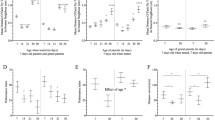Abstract
We have monitored the ontogeny of several behaviors performed by young Drosophila melanogasteradults. Very young flies are less active than older flies and are less responsive to gravity, light, an odorant, and sucrose applied to their tarsi. In addition, very young males do not consume sucrose or perform any courtship behaviors in response to virgin females, which provide chemical and visual stimuli to courting males. The rate at which flies become maximally competent to respond to stimuli is a function of the behavior. Sensory and motor deficits are not solely responsible for young flies' inability to respond to the stimuli, which suggests that the central nervous system continues to develop after eclosion.
Similar content being viewed by others
References
Baker, B. S., and Ridge, K. A. (1980). Sex and the single cell. I. On the action of major loci affecting sex determination in Drosophila.Genetics 94: 383–423.
Belote, J. M., and Baker, B. S. (1987). Sexual behavior: Its genetic control during development and adulthood inDrosophila melanogaster.Proc. Nail. Acad. Sci. 84: 8026–8030.
Cline, T. C. (1984). Autoregulatory functioning of a Drosophila gene product that establishes and maintains the sexually determined state.Genetics 107: 231–277.
Dudei, Y., Jan, Y.-N., Byers, D., Quinn, W. G., and Benzer, S. (1976).dunce, a mutant ofDrosophila deficient in learning.Proc. Natl. Acad. Sci. 73: 1684–1688.
Eastwood, L., and Burnet, B. (1977). Courtship latency in maleDrosophila melanogaster.Behav. Genet. 7: 359–372.
Ford, S. C., and Tompkins, L. (1985). An assay to measure the consumption of attractants in solution.Dros. Inform. Serv. 61: 194.
Greenspan, R., Finn, J. A., and Hall, J. C. (1980). Acetylcholinesterase mutants in Drosophila and their effects on the structure and function of the central nervous system.J. Comp. Neurol. 189: 741–774.
Hall, J. C. (1977). Portions of the central nervous system controlling reproductive behavior inDrosophila melanogaster.Behav. Genet. 7: 291–312.
Hall, J. C. (1979). Control of male reproductive behavior by the central nervous system of Drosophila: dissection of a courtship pathway by genetic mosaics.Genetics 92: 437–457.
Hall, J. C. (1982). Genetics of the nervous system inDrosophila.Q. Rev. Biophys. 15: 223–479.
Hirsch, H. V. B. (1985). The tunable seer: activity-dependent development of vision. In Blass, E. M. (ed.),Handbook of Behavioral Neurobiology, Vol. 8, Plenum, New York, pp. 237–295.
Jacobs, M. E. (1980). Influence of β-alanine on the ultrastructure, tanning, and melanization ofDrosophila melanogaster cuticles.Biochem. Genet 18: 65–76.
Jallon, J.-M, and Hotta, Y. (1979). Genetic and behavioral studies of Drosophila female sex appeal.Behav. Genet. 9: 257–275.
Leffelaar, D., and Grigliatti, T. (1984). Age-dependent behavior loss in adultDrosophila melanogaster.Dev. Genet. 4: 211–227.
McRobert, S. P., and Tompkins, L. (1987). The effect of light on the sexual behavior ofDrosophila affinis.Behav. Neural Biol. 47: 151–157.
Mimura, K. (1986). Development of visual pattern discrimination in the fly depends on experience. Science232: 83–85.
Miquel, J., Lundgren, P. R., Bensch, K. G., and Atlan, H. (1976). Effects of temperature on the lifespan, vitality, and fine structure ofDrosophila melanogaster.Mech. Age. Dev. 5: 347–370.
Napolitano, L. M., Ford, S. C., and Tompkins, L. (1986). The effects of developmental and environmental temperature on responses ofDrosophila melanogaster adults to sucrose.J. Insect Physiol. 32: 937–940.
Pak, W. L., and Grabowski, S. R. (1978). Physiology of the visual and flight systems. In Ashburner, M., and Wright, T. R. F. (eds.),The Genetics and Biology of Drosophila, Vol. 2a, Academic Press, New York, pp. 554–604.
Quinn, W. G., and Greenspan, R. J. (1984). Learning and courtship in Drosphila: two stories with mutants.Annu. Rev. Neurosci. 7: 67–93.
Quinn, W. G., Harris, W. A., and Benzer, S. (1974). Conditioned behavior inDrosophila melanogaster.Proc. Natl. Acad. Sci. 71: 708–712.
Samis, H. V., Rubenstein, B. J., Zajac, L. A., and Hargen, S. M. (1981). Temporal organization and aging inDrosophila melanogaster.Exp. Gerontol. 16: 109–117.
Schilcher, F., and Hall, J. C. (1979). Neural topography of courtship song in sex mosaics ofDrosophila melanogaster.J. Comp. Physiol. 129: 85–95.
Siegel, R. W., Hall, J. C., Gailey, D. A., and Kyriacou, C. P. (1984). Genetic elements of courtship in Drosophila: Mosaics and learning mutants.Behav. Genet. 14: 383–410.
Sturtevant, A. H. (1915). Experiments on sex recognition and the problem of sexual selection in Drosophila.J. Anim. Behav. 5: 351–366.
Technau, G. M. (1984). Fiber number in the mushroom bodies of adultDrosophila melanogaster depends on age, sex, and experience.J. Neurogen. 1: 113–126.
Tompkins, L. (1984a). Genetic analysis of sex appeal in Drosophila.Behav. Genet. 14: 411–440.
Tompkins, L. (1984b). The effect ofSex-lethal mutations on the sexual behavior ofD. melanogaster.Genetics 107: 107.
Tompkins, L. (1986). Genetic control of sexual behavior inDrosophila melanogaster.Trends Genet. 2: 14–17.
Tompkins, L., and Barnhart, K. (1982). A new technique for the proboscis extension assay.Dros. Inform. Serv. 58: 171–172.
Tompkins, L., Hall, J. C., and Hall, J. M. (1980). Courtship-stimulating volatile compounds from normal and mutant Drosophila.J. Insect Physiol. 26: 689–697.
Tompkins, L., Gross, A. C., Hall, J. C., Gailey, D. A., and Siegel, R. W. (1982). The role of female movement in the sexual behaviorof Drosophila melanogaster.Behav. Genet. 12: 295–307.
Author information
Authors and Affiliations
Additional information
Deceased
Rights and permissions
About this article
Cite this article
Ford, S.C., Napolitano, L.M., McRobert, S.P. et al. Development of behavioral competence in youngDrosophila melanogaster adults. J Insect Behav 2, 575–588 (1989). https://doi.org/10.1007/BF01053355
Accepted:
Issue Date:
DOI: https://doi.org/10.1007/BF01053355




